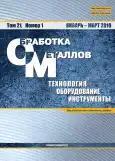Введение. Применение алмазных шлифовальных кругов на металлической связке для шлифования быстрорежущих сталей большинством литературных источников рекомендовано с помощью электрофизических, электрохимических или комбинированных методов обработки. Одновременно рекомендуется ограничить область применения окончательным круглым шлифованием в силу появления на обработанной поверхности дефектного слоя либо снизить технологические режимы обработки. К его сигнальным признакам относятся систематические сколы вдоль режущей кромки и микросколы на передней поверхности образцов, размеры карбидных частиц, отдельные кратеры или лунки на передней поверхности, снижение твердости, увеличение высоты микронеровностей профиля. Статья посвящена определению таких технологических режимов комбинированной электроалмазной обработки инструмента из быстрорежущей стали Р6М5, при шлифовании на которых отсутствовали бы сигнальные признаки дефектного слоя. Если решить эту задачу, то возможно расширить область применения алмазных шлифовальных кругов на металлической связке при обработке инструментальных сталей. Предмет исследования: пластины из быстрорежущей стали для металлорежущего инструмента; объект исследования: технологический процесс комбинированной электроалмазной обработки. Цель работы: изучение влияния технологических режимов комбинированной электроалмазной обработки на качество поверхностного слоя инструмента из быстрорежущей стали. Методы исследования. Операция шлифования проводилась на универсально-заточном станке модели 3Д642Е, модернизированном под технологию комбинированной электроалмазной обработки. Применялся шлифовальный алмазный чашечный круг на металлической связке: АС6 80/63 М1 100 %. Электрические параметры исследовались в диапазоне: iпр=0,17…0,25 А/см2; iтр = 3,125…9,375 А/см2 соответственно. Механические параметры исследовались в диапазоне: V=17–35 м/сек; t=0,01–0,03 мм/дв.ход; S = 1,5 м/мин. Шлифование велось с применением электролита: NaNO3 – 3 %, NaNO2 – 1 %, Na2CO3 – 0,5 %, остальное вода. Микроструктурные исследования проводили на микрошлифах образцов после травления. Качество поверхности оценивали с помощью растровой электронной микроскопии (Carl Zeiss EVO50 XVP); методом световой микроскопии (МЕТАМ ЛВ-42); шероховатость определялась с помощью профилограф-профилометра (Абрис-ПМ7); твердость HRC определялась с помощью твердомера Роквелла (600 MRD). Результаты и обсуждение. Установлено, что наилучшим сочетанием технологических режимов, при обработке на которых отсутствуют признаки дефектного слоя и сохраняется высокое качество металлорежущего инструмента из быстрорежущей стали, следует считать следующие: V = 35 м/сек; S=1,5 м/мин; t = 0,02 мм/дв.ход; iпр = 0,25 А/см2; iтр = 6,25 А/см2. Выявлено, что при обработке на рекомендуемых режимах режущая кромка ровная, с неглубокими зазубринами, размер карбидных частиц составляет в среднем 2…5 мкм. Установленные режимы позволяют получить шероховатость передней поверхности Ra = 0,070 мкм. Обнаружено, что полученная твердость на 6 % превышает исходную твердость и составляет 67…70 HRC.
 6-15
6-15


 16-24
16-24


 25-34
25-34


 35-49
35-49


 50-60
50-60


 61-69
61-69


 70-81
70-81


 82-92
82-92


 93-107
93-107


 108-121
108-121








